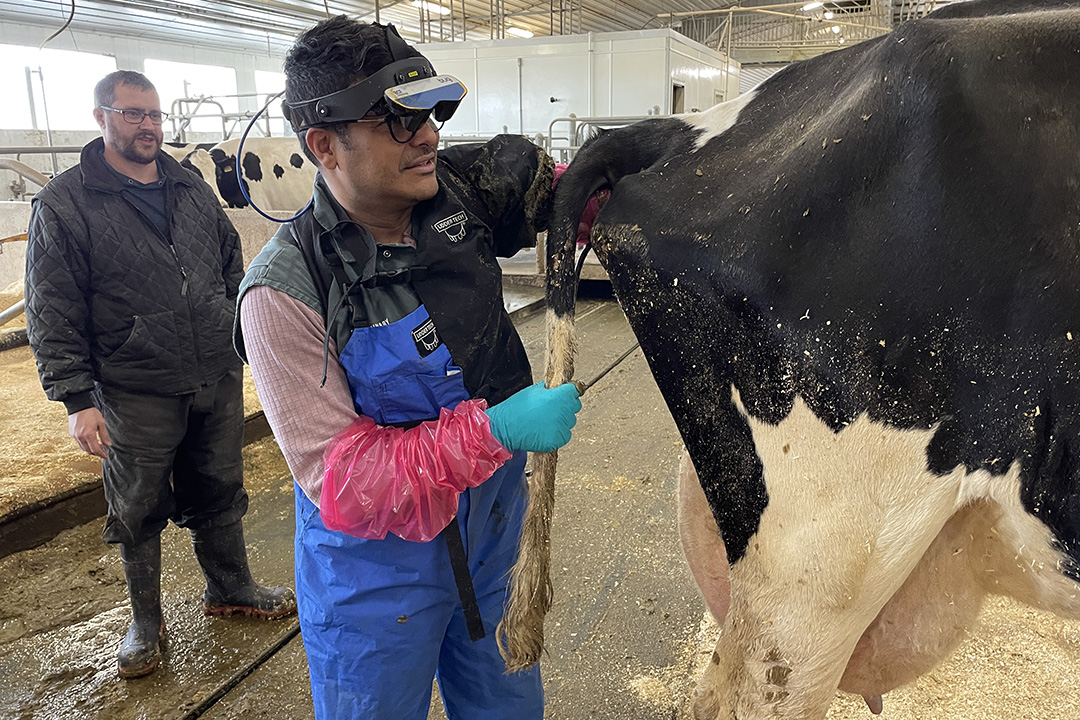
Probiotics for pregnancy: does the uterine microbiome influence a cow’s fertility?
Since the community of microorganisms (or microbiome) living in your gut can influence digestion and overall health, eating yogurt or taking probiotics can improve your gut function. But what about the microbiome in the uterus: could the bacterial composition inside the womb influence pregnancy rates?
By Sian Nielsen
It’s one of the questions challenging Dr. Dinesh Dadarwal (BVSc&AH, PhD), an assistant professor and food animal theriogenologist at the Western College of Veterinary Medicine (WCVM) whose reproductive research focuses on the uterine microbiome in cattle. Several recent studies have investigated the uterine microbiome in women, but in female cows, this topic is a relatively new field of research.
Anyone familiar with beef and dairy industries knows how important pregnancy rates are for production: it’s estimated that cattle producers lose between $600 million and $1.4 billion every year due to lack of conception and loss of pregnancy.
Since producers invest a lot of time and money into their herds, they’re always seeking ways to improve cattle health and avoid costs associated with replacing sick or unproductive animals.
“In dairy cows it takes a few lactations (the period from calving to when milk production stops) to start yielding a return on investment,” says Dadarwal. “Starting over is an option, but it’s not economically viable.”
He adds that his research team’s key aims are to enhance animal health and reduce disease among cattle herds.
“We are not after increasing production with higher milk yield. We are after increasing uterine health while maintaining production levels.”
A cow must have a healthy, functioning uterus before a pregnancy can be established and maintained, so Dadarwal and his team are working to determine the composition of a healthy bovine uterus. They’re investigating the influence of bacteria and other microbes on uterine function, plus they’re studying what could help to decrease uterine infections and inflammation — measures that can reduce the need for antibiotics and replacement heifers.
“Uterine infection and inflammation is seen in 20 to 50 per cent of cows, which can last many weeks post-calving — prolonging the interval to the next pregnancy and leading to embryonic losses, which is particularly significant in dairy cattle,” says Dadarwal.
“In many cases antibiotics are the standard course of treatment, but those come with withdrawal periods and the risk of creating antibiotic resistance. We don’t know how antibiotic treatments are affecting the microbiome. In destroying these microbes, are we inadvertently causing more harm and disrupting the uterine environment?”
To better study uterine infections, Dadarwal is collaborating with Dr. Janet Hill (PhD), a microbiology professor and researcher at the WCVM. Her extensive research in the microbiome field has included studies involving the reproductive microbiome of humans, and she’s been able to apply her knowledge of microbiology to real clinical settings.
Hill considers her research involving the reproductive microbiome as important not only for understanding fertility and reproductive success but also for acquiring knowledge about diseases and cancers and the relationship of the maternal microbiome to health of offspring.
“Understanding host-microbe relationships in the uterus is a huge part of this project,” says Hill. “If we understood the environment and relationships between microbes themselves and between the microbes and the host, we could manipulate the environment to get a desired response.”

For their study, the WCVM scientists use uterine and vaginal swabs from healthy cows to culture bacteria and conduct genetic sequencing — with the goal of learning the composition of normal uterine microbiome of a healthy cow. This information serves as a benchmark so the researchers can compare the uterine microbiomes of cows at various periods post-calving.
During the weeks following birth, the bovine uterus undergoes a natural recovery process that includes a normal level of inflammation and the presence of bacteria. But after five weeks, a high level of inflammation is considered chronic.
Interestingly, this inflammation is caused by bacteria considered commensal (bacteria that forms beneficial partnerships with their hosts). What remains unknown are the factors responsible for triggering the commensal bacteria to alter their phenotype. Dadarwal and his team plan to use the results of their baseline research to identify niches that favour normal microbial community in a healthy uterus.
This information will lead to more questions for the scientists: if the microbes are the same, what causes them to become agents of disease? If the microbes are newly introduced, where did they come from?
“One of the big challenges with studying the microbiome is that you are looking for things you cannot see and trying to identify bacteria that you cannot culture,” says Dadarwal.
For Hill, the challenge is recognizing the need to move away from solely identifying bacteria and toward understanding their niches in the environment: “The uterus might seem small, but to bacteria, it is massive with many different habitats and roles to fill.”
Once the scientists know which microbes to support, they can use that information to improve uterine health and overall animal health, especially in postpartum cows that have undergone a huge stress on their bodies.
Over the next few years, Dadarwal and his research team will evaluate uterine samples as well as blood samples and liver biopsies from dairy cows. While liver biopsies will provide information about metabolism, blood samples will provide information about immune response systemically, providing a more complete picture of how the uterus reacts in relation to the entire body.
For Dadarwal, the ultimate goal is to provide information that will enhance management and preventive care so infections and inflammation in cows don’t become chronic — necessitating antibiotic use.
“To be able to minimize our reliance on antibiotics to prevent and treat uterine infection would be an enormous achievement,” says Dadarwal. “This action would reduce costs for producers and improve animal well-being.”
The Natural Sciences and Engineering Research Council of Canada (NSERC) is providing financial support for this research study.
Sian Nielsen of South Slocan, B.C., is a second-year veterinary student at the WCVM. Her story is part of a series of articles written by WCVM summer research students. Dr. Dinesh Dadarwal of the WCVM was Nielsen’s summer research mentor in 2023.
